
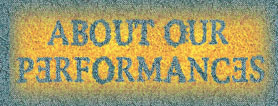




Tartu Children's
Theatre was founded in October 1989. It is a little experimental
theatre with black-box type of stage. Our work is aimed both to
very young people and older audience too. Philosophical content
of our production as well as using different forms of stage
language have always been equally important for us. We try also
not to go along with commercial culture, but to make a theatre
for audience, who is willing to think and look at life from more
than one point of view and who will do that with us.
Tartu Children's Theatre is a member of ASSITEJ.
We hope that our productions may interest those, who compile
programs of festivals.
![]()

![]()
W.Huygen,M.Kampus
JUST A
GNOME
Directed by: Mart Kampus
Scenography: Piret Räni
Coreography: Kristina Paskevichius
Actors: Elgitha Zeno, Merle Antson, Helen Hansberg, Maare-Marika
Heinsoo, Taago Tubin, Tiit Toomel.
Duration 45 minutes
Age range of intended audience: age 4 and up, also for
grown-ups.
A documentary about this little folk, where a lot of gnome-lore is given according to Wil Huygen's “the Big Gnome Book”. The habits and anatomy of the real gnomes (but not polished Christmas dwarves) are under observation. Motifs from the music of Meredith Monk are used.
We will get to
know gnomes better through humour and playful presentation of the
useful knowledge.

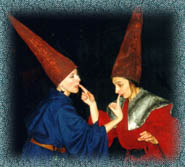
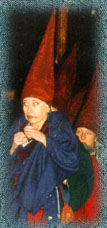
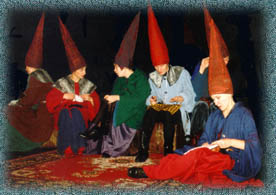
A play for those who still do or want to believe in dwarfs and
even to those who do not know themselves that they do not know a
thing about dwarfs.
![]()

![]()
CAT THE WEAVER, DOG THE PIPER
Directed
by: Anne Türnpu Actors:
Merle Antson, Sven Antson, Maare-Marika Heinsoo,Taago
Tubin ja Elgitha Zeno Based on old Estonian animal-stories and folk-songs, the means and visual language of this performance make up a symbiosis of cultural traditions from different primitive societies. For example the setu folk-songs and indian-inspired totem-masks.
|
![]()

![]()
Heino Väli, Mart
Kampus
The
CATERPILLAR and Its MIRROR
Directed by: Mart Kampus
Scenography: Piret Räni
Actors: Elgitha Zeno ja Taago Tubin
Age range of intended audience: age 4 and up.
Duration: 40 minutes
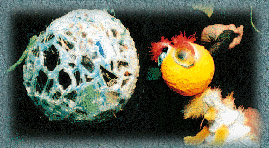
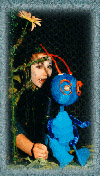
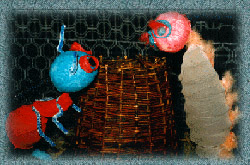
"Nobody has
such pretty eyelashes or such red flecks in the eyebrows,"
the Caterpillar assures itself. And it closes its eyes. Thus it
is every day - the Night lends it a dewdrop mirror, the Day
snatches it off from before its very eyes. But the Caterpillar
finds nothing worthy of its glance but itself.
"Oh, how I long to have a mirror that the Day couldn't
snatch off! Or perhaps I think I should go searching for such a
mirror? For a mirror is indeed a marvellous thing: there I can
always see myself and look at myself..."
And the Caterpillar sets out. Those whom it meets have a
completely different idea of mirrors: for them, that with which
they are diligently employed every day is the mirror where they
can see themselves.
And when the Caterpillar becomes a butterfly, it spots a
caterpillar on a blade of grass. "How pretty it is... and
lazy, too... and, I reckon, silly and vain as well! But perhaps I
think I have seen something like this before?!" She
continues her flight towards the end of the forest where flowers
are waiting to be pollinated.
![]()

![]()
Eva Wigström,
Per Lüsander, Suzanne Osten
PRINCE
JOYFUL
(PRINS
SORGFRI)
Directed by:
Taago Tubin
Scenography: Anne-Mai Heimola
Actors: Elgitha Zeno, Merle Antson, Janek Sarapson, Tiit Toomel,
Kalev Kudu
Duration: 1 hour and 15 minutes
Age range of intended audience: age 7 and up, also for
grown-ups.

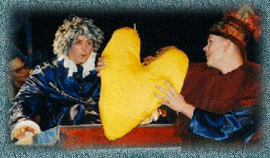

A son is born
to the king. With sorrow, as the Queen dies while giving birth.
To ward off the pain of the world the king surrounds his kingdom
with a wall and inside it everybody has to be happy. But the
prince finds neither peace nor happiness – and here begins the
journey to find the “something” he has been deprived of.
Music, fighting, dances and songs all feature.
![]()

![]()
G.Jakowiak
JESPER'S
LUCK
Directed by:
Katrin Nielsen
Scenography: Inga Vares
Actors: Aldar Talviste, Sven Antson, Maare-Maarika Heinsoo, Helen
Hansberg ja Enn Lillemets.
Duration: 1 hour
50 minutes
Age range of intended audience: age 7 and up.
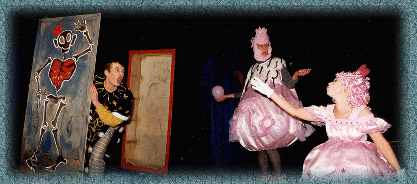
Jesper is an
ordinary boy (a boy as a boy should be). And his parents are
perfectly “normal”. To teach him some manners they lock him
up in his room for four weeks. Grouchy Luck and joyful Mishap
come to his aid; creatures of fantasy stir Jesper's imagination
and help him gain confidence.
The play is for children who already know how much is four minus
seven, but don’t yet know the ways of love.
![]()

![]()
Peter S. Beagle
THE LAST
UNICORN
Directed by: Mart Kampus
Scenography: Liina Keevallik
Actors: Elgitha Zeno, Maare-Marika Heinsoo,Merle Antson,Anne
Maasik, Sven Antson, Taago Tubin, Tiit Toomel, Enn Lillemets.
Composer Mait Reimann
Duration: 2 hours
20 minutes
Age range of intended audience: age 7 and up, also for
grown-ups. Best for college-people and students.



An unicorn of
colour of the falling snow lives all alone in lilac woods. He has
no conception of time - neither years nor months or centuries,
even seasons.
One day the Unicorn finds out that he’s the last of his race
with all others long gone. And he leaves his forest to search for
them. This is the beginning of an enchanting game where the last
unicorn will see magic and humanity, meet dangers and love.

A play for those who have already been and for those who are
about to fall in love.
![]()

![]()
J.Viiding/T.Rätsep
THE BEINGS
Directed by:
Taago Tubin
Scenography: Piret Räni
Coreography: Heli Kohv
Actors: Enn Lillemets, Aldar Talviste, Tiit Toomel, Kalev Kudu,
Anne Maasik, Elgitha Zeno, Merle Antson, Helen Hansberg, Hille
Hendrikson , Taago Tubin
Duration 1 hour 50 minutes.
Age range of intended audience: age 4 and up, also for
grown-ups.
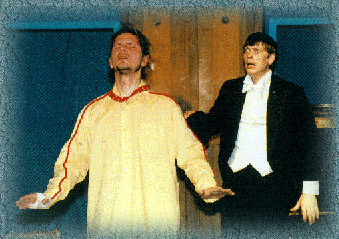

Am I me? Who am
I? Where do I belong to? These are the questions asked by
CREATURES from dumping grounds. Little by little they discover
the world of humans they one day the wish to become.Will they
ever succeed ?
A play for those who like to ask questions and want to become
someone, and for those who forgot to ask the questions when they
were little.
![]()

![]()
Monika Feth,
Taago Tubin
THE
WIZARDS
("Der Gedankensammler")
Directed by:
Taago Tubin
Scenography: Piret Räni
Coreography: Heli Kohv
Actors: Heli Kohv ja Kalev Kudu.
| Have you ever thought
about this what would happen if thoughts continued
repeating themselves and one day came to end? Mr Grumpy
has given thought to that and is collecting thoughts. As
a matter of fact he can hear them and has the means and
helpers to gather, store, plant and sow them… Actually we shouldn’t talk too loud of them even here, as thoughts are very easily frightened. Age range of intended audience:
age 4 and up, also for grown-ups. |
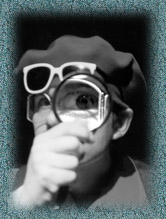 |
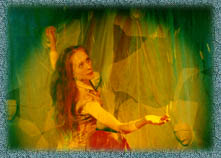
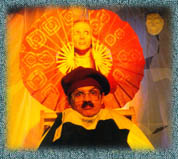

![]()

![]()
SOAP-FREE
CHILDRENS' THEATRE
The recent first night of “Cat the Weaver…” was Estonians’ farewell to the folk of the sky-elk (the mystical name for the Finno-Ugrians).
At times “Cat the Weaver…” resembles a happening. The spectators are asked riddles, actors are in close contact with the audience, offering them a film-like intimacy, exposing the slightest nuances, although the masks are drawn and faces hidden. The mask, your alter ego , is another face to look at when the going gets tough. The actor-mask communion is nothing revolutionary in itself. It just does not belong to the tradition of Estonian culture.
Indian and Estonian
It’s hard to determine the Indian influences in the play. It’s even harder to tell if it is based on Estonian folklore. Not only that “Indian” is a term covering two continents, but even “Estonian” becomes questionable if the “Setu” get included. (Being neither Estonians nor Russians, the “Setu” make up an independent ethnic group on the border-lands)
As regards the direction, “Cat … “ is a performance with international influences; the Chinese gong echoes the theatre of the Orient, the same goes for the pentatonic interludes, the actors wear Afro-braids — the world is small enough.
The weaving stories end without a dénouement. The moral is sketched out but the conclusion is withheld, which is not customary with the Indo-European tradition. No pointe. Banality remains unuttered in words and this is praiseworthy. Who on earth would take “They lived happily ever after” seriously?
The life of the heroes at the end of the story is by no means more “normal” than in the beginning and the events are unmotivated in the strictly causative linear sense. Nobody is going to ask the Fox where he is going to ride on his horse-sleigh, why doesn’t the horse talk, as if it were an outsider of the animal society, or why do the Bear, the Wolf and the Rabbit ask for a ride if the destination has no importance. The heroes seem to move from place to place for no other reason that they are simply able to do so.
The “Cat… “ is free of “soap” — soapfree, strictly uncommercial and oriented to those areas that the Barbie-dynasty has not yet conquered.
Martin Sõmer
![]()
May 6, 1999 was the first night of Prince Joyful at Tartu Lasteteater. Director Taago Tubin has created a spectacular and lively play, yet serious at a deeper level, about a prince whom his father, the king, hopes to arise in an idyllic world inside high walls that no pain or grief can cross. But, as the prince grows, so does his interest in the outer world. So one day he decides to “travel to the other side” and has to suffer great pain in getting to know sorrow.
The play by Taago Tubin sets no limit to the age of the audience.[---] The play is integrated yet still full of variety; the scenography by Anne-Mai Heimola open to quick changes. Resourceful choreography (by Heli Kohv) and fights (Janek Sarapson) enliven the play while the musical setting and the choice of songs add nuances worth listening to.
The final song after the curtain has fallen makes us think of eternal sorrow and the everlasting desire of a man to find sanctuary in a happy end.[---]
Janek Sarapson’s joyful and expressive Prince sensitively concentrates on the childhood of the prince, leaving somewhat obscure his inner dialogue and his struggle to grow into manhood. The rest of the team dynamically moves from one role to another. Merle Antson, Elgitha Zeno, Tiit Toomel and Kalev Kudu have to act the king and his royal court, death and tombstones … The theme of death in the play is suggestive, the departure of the King from stage in a white death-mask unforgettable.[---]
The
core of the repertoire of Tartu Lasteteater has never been
trivial. Neither Jesper’s luck nor Prince Joyful offer the
audience an easy way out. The serious discussion with the young
audience will also intrigue the adults [---] To build a “wall”
between adults’ and children’s theatre is artificial.
Children especially (“the grown-up children” in its positive
sense) are having dialogues with open and perplexed inner
questions.
Ability to open-mindedly think of the world and the human nature,
to ask essential and eternal questions –isn’t this the real
role of a good children’s’ theatre?
Pille-Riin Purje "Kultuurikaja" 15. mai 99.a.
![]()
THE HARD ROAD TO GETTING HUMAN
“The Beings” by Juhan Viiding and Tõnis Rätsep, directed by Taago Tubin was staged on April 11,1998, at Tartu Children and Youth Theatre.
The Tartu Children and Youth Theatre has this time chosen a play from among the Estonian contemporary theatre classics.
“The Beings”
was premiered in 1980 at the Estonian Drama Theatre. After that
it was performed in Toronto Estonian Theatre in 1994. Its
receptions differed as critics in Soviet Estonia at the time saw
the absurd philosophy as key, having problems interpreting the
hints and symbolism of the play. The exiles on the other hand saw
the keen socio-political allegory; the gun found in the dumping
ground connects with the struggle for independence, a typewriter
with the lack of freedom of speech. It even prophecies the
emerging capitalism in independent Estonia, when finding money
splits the former friendly unity into the rich and the poor.
Taago Tubin has stressed the essentially human aspects and
avoided references to everyday matters. Thus has “The Beings”
obtained a strong power of generalization, becoming a “peril-drama”
with elements of an absurd-comedy.
8 unnamed “beings”, bearing numbers only, explore the frontiers of human thought in sparkling dialogue, paradoxical prophecies, childish arguments and obscure speculations. Now and then a crystal-clear glimpse of the truth appears among the somersaults of thought.
The creatures, who passionately, even desperately, wish to become human; are ourselves, we recognise with sudden clarity.
Aivar Kull
![]()
The Beings
* Finding references to the “beings” in our society shouldn’t be too difficult as we have the Teletubbies, the homeless etc.
*The authors take one more step backwards. It is easy to turn a new page as a ready-made human being. But becoming one and proving to be one is something different. Adding the witty, sarcastic, elegant and hyperbolically paradoxing dialogue, it goes without saying that this play should be seen by every lover of Juhan Viiding’s works.
Sven Karja
![]()
HOW TO WRITE THE GREAT GNOME-BOOK
Director Mart Kampus has created a friendly and mystical dwarf-world, where little gnomes spend their days singing, dancing and telling tales to the small ones. The play is for an audience of any age and parents can enjoy it together with their children. The dwarves are real, their songs and dances charming and performed with great warmth of heart.
Margot Visnap
![]()

![]()
Tartu Lasteteater / mängukava / ajalugu / repertuaar / inimesed / Tartu Lasteteater in english